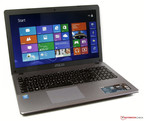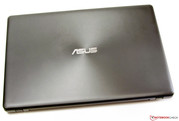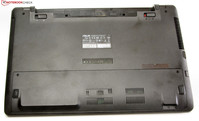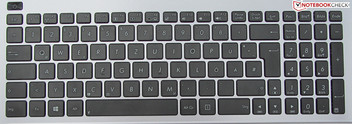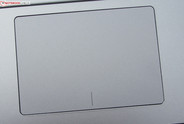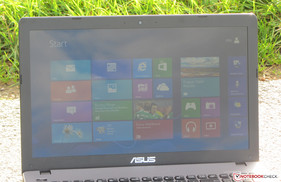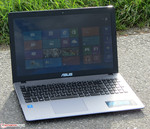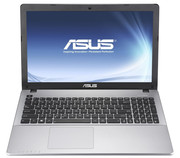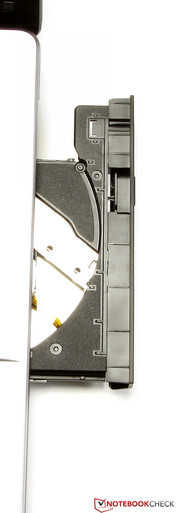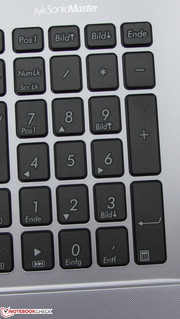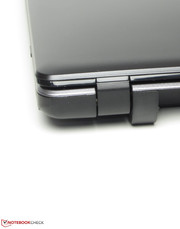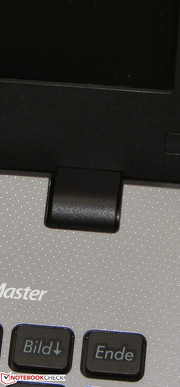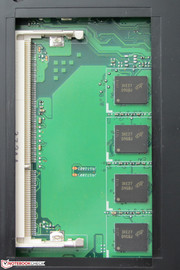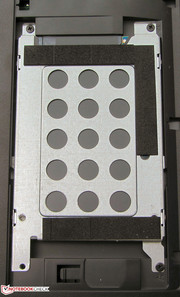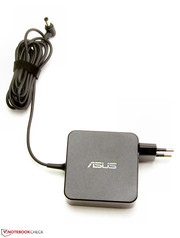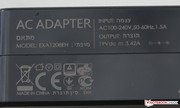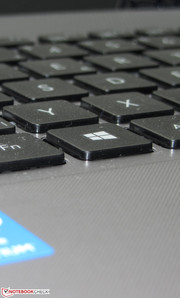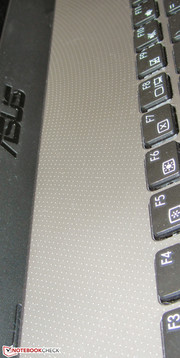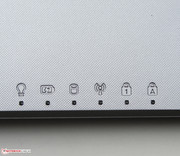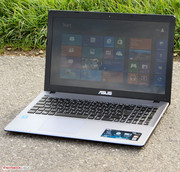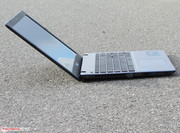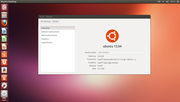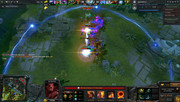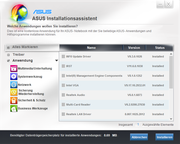Review Asus F550CA-XX078D Notebook

For the original German article, see here.
With the F550CA series, Asus expands the assortment of low-priced notebooks by a few more models. The name indicates that this is the successor of the F55A series. Despite the similar names, they do not have much in common though. With the F55A-SX099D (Pentium B980, HD Graphics (Sandy Bridge)) we have already tested a model of the F55A series. It is a sturdy notebook that is equipped with a very unconventional keyboard, which needs a lot of time to get used to. Our test will show if the F550CA can do it better.
For classification purposes we compared the notebook to its competitors Lenovo G500s (Pentium 2020M, HD Graphics (Ivy Bridge)) and Toshiba Satellite C50D-A-10E (AMD A4-5000, Radeon HD 8330).
The price level of the F550CA already hints that the buyer cannot expect aluminum elements. The entire case is made of plastic. This is something the Asus notebook has in common with the G500s and the Satellite. It suits the F550CA really well that Asus refrained from using shiny materials. Asus uses two colors: The top of the base unit shines in silver-gray and the bottom as well as the back of the lid are in black. The palm rest and the back of the lid are additionally topped off with a texture. The back is equipped with grooves that spread circularly around the center. The palm rest is furnished with a very fine grid.
Given the purchase price, the stability of the case is very decent. The base unit can slightly be bent on the left side of the keyboard and underneath the touchpad. This behavior is very typical for notebooks. The torsional rigidity is also acceptable. Although the base unit can slightly be twisted this is still within tolerance range. The lid, however, can be twisted too much. It causes image deviations. The latter also occurs when pressure is applied to the back side of the lid. The hinges keep the lid tightly in its position but bounce slightly. The lid can be opened with one hand as long as it is opened slowly and carefully jiggled.
All three notebooks come up with the nowadays-standard interfaces. The F550CA is the only device that comes with a Gigabit-Ethernet socket. The Satellite and G550s only have to offer Fast-Ethernet. Nice: Every notebook is equipped with at least one USB 3.0 slot. The layout of interfaces of the F550CA is only partly well done. All interfaces at the left side are situated at the level of the palm rest making it difficult for left-handers to use a mouse. However, the right side is free of slots.
Communication
Regarding communication modules, Asus relies on two old friends that we have encountered in countless notebooks. Wired network connections are handled by a Gigabit-Ethernet chip of the RTL8168/8111 family from Realtek. The WLAN module carries the AR9485 chip from Atheros, which supports the WLAN standards 802.11 b/g/n. The WLAN reception worked flawlessly at all times. Within a radius of up to 15 meters (~49 feet) around the router the F550CA displayed full reception. This also applies across two stories. The built-in webcam shoots muddy pictures with a resolution of up to 1280x720 pixels.
Accessories
Besides a small manual and warranty information, the notebook is accompanied by a driver DVD for Windows 8 (64-bit).
Operating System
The version of the F550CA that we tested comes without a Windows operating system. FreeDos is preinstalled. Using Windows 7 or Windows 8 does not pose a problem. Asus offers the respective drivers for both operating systems as a download. The drivers for Windows 8 (64-bit) are also included on the driver DVD of the notebook. All drivers can be easily installed in one go. We installed Windows 8 Pro (64-bit) to conduct our benchmarks.
As a test, we also installed Ubuntu Linux 13.04. All hardware components as well as the function buttons for brightness and volume worked directly after the installation. The WLAN module proved to be the only problem. It was detected properly and the respective driver installed, however, the module was deactivated by the hardware. Additionally, we plugged a USB WLAN stick into the device, which was also deactivated. We were neither able to activate the modules with the help of the button for activation/deactivation of the flight mode nor with one of the numerous solutions offered on the Internet.
A lucky guess finally activated the WLAN module. We put the notebook in sleep mode (key combination: FN + F1) just to wake it up right afterwards. The WLAN module ran instantaneously and we were able to set up a connection to the router. Unfortunately, this procedure has to be repeated after every reboot of the device to reactivate the WLAN module.
Maintenance
Main memory and hard drive are located underneath the maintenance hatch. To access the remaining components the notebook would have to be dismantled to a great extent. The F550CA is equipped with one main memory bank that is not yet occupied by a module. Instead, Asus soldered the 4 GB main memory directly on the mainboard. The hard drive can be replaced quickly and easily by another model. Models with a design height of 9.5 and 7 mm fit into the notebook.
Warranty
The F550CA comes with a 12-month warranty. The same goes for the Satellite. Owners of the G500s are treated to a two-year warranty. The warranty period of the Asus notebook can be extended to three years. The corresponding warranty extension is available for roughly 85 Euros (~$115).
Keyboard
Asus equips the F550CA with an unlit chiclet keyboard along with a numeric keypad. The main keys have a footprint of about 15 x 15 mm. Overall the slim and slightly roughened keys have a medium stroke and a clear pressure point. The key resistance could have been somewhat tighter. The keyboard bounces noticeably when typing, which is more apparent in the center than on the sides. This behavior also influences the typing feeling. The keyboard feels better overall at the sides. Those who have to type a lot and frequently might not be too happy with the keyboard. It suffices, though, for common use.
Touchpad
As a mouse substitute, Asus uses a multi-touch capable clickpad. With a surface of 10.4 x 7.3 cm (~4.1 x 2.9 inches), it is quite generously dimensioned. Therefore, the user has enough space for the comfortable use of multi-touch gestures. Furthermore, the smooth surface of the pad makes gliding easy for the fingers. The multi-touch gestures can be turned on and off individually in the context menu. The clickpad does not have separate mouse buttons. The whole pad is one big button. When the pad is clicked in the lower part, it recognizes, based on the finger position, if the left or right mouse button is meant. The pad has a short stroke and a clearly audible and palpable pressure point.
Asus fits the F550CA with a glossy 15.6-inch display from Chi Mei. It has a native resolution of 1366x768 pixels. Asus does not offer any other display types. With 207.3 cd/m² the average brightness of the display is average. The values of the Satellite (218.1 cd/m²) and the G500s (210.8 cd/m²) are similar to that of the F550CA.
| |||||||||||||||||||||||||
Brightness Distribution: 91 %
Center on Battery: 217 cd/m²
Contrast: 779:1 (Black: 0.28 cd/m²)
ΔE ColorChecker Calman: 8.01 | ∀{0.5-29.43 Ø4.77}
ΔE Greyscale Calman: 8.49 | ∀{0.09-98 Ø5}
39.7% AdobeRGB 1998 (Argyll 1.6.3 3D)
42.77% AdobeRGB 1998 (Argyll 3D)
61.5% sRGB (Argyll 3D)
41.29% Display P3 (Argyll 3D)
Gamma: 2.82
CCT: 10582 K
The contrast (779:1) and black value (0.28 cd/m²) of the screen are very convincing. The values of the Satellite (668:1, 0.33 cd/m²) are only slightly worse while the G500s (313:1, 0.69 cd/m²) trails far behind. The screen of the F550CA cannot display the color spaces sRGB and AdobeRGB, but no one should expect this for this price anyway. Additionally, color spaces are irrelevant for most of the users since they are mainly important for professional image editing.
A look at CalMAN's data quickly reveals that the display of the F550CA has a blue cast. This is nothing unusual and occurs in many displays - especially in the low price segment. With a value of 8.01 the average DeltaE 2000 deviation turns out to be quite moderate. Some blue hues, darker colors and grayscales exceed this value. Only the color bluish-violet reaches the target area (DeltaE smaller than 5).
The notebook is not suited for working outdoors. Although, owing to the high contrast, the content of the screen is recognizable to some extent it does not suffice to work comfortably with the computer over longer periods of time. The mediocre brightness and the glossy surface prohibit this.
The F55CA, too, shows the typical behavior of cost-effective notebooks: Changing the vertical viewing angle quickly causes the image to break down. The horizontal viewing angle stability is better. The image content can also be read from the side; however, the image darkens increasingly.
Asus offers within the F550CA series budget-priced notebooks that are suited for the execution of daily tasks like secretarial work, Internet communication and video playback. Current computer games can be played to a limited extent. Our test device is currently available for about 320 Euros (~$433). Additionally the series offers other equipment versions. The differences can be found in the processor (Pentium 2117U, Core i3-3217U, Core i5-3337U), the operating system and the size of the hard drive. Asus follows - as already done for the F55A series - a two-pronged strategy by introducing a structurally identical series to the market. All statements about the F550CA also apply to the X550CA. Those who want a gaming notebook should have a look at the F550CC and X550CC series. These models are additionally equipped with a dedicated GeForce GT 720M graphics core.
Processor
A Pentium 2117U processor is deployed in the F550CA. This Ivy-Bridge dual-core processor runs at a speed of 1.8 GHz and has no turbo. The Pentium is part of the ULV processors. The trademark of these CPUs is their relatively low power consumption. Intel indicates for the Pentium a TDP of 17 Watts.
The processor constantly runs at 1.8 GHz throughout the CPU tests of the Cinebench benchmarks - no matter if plugged in or in battery mode. It comes as no surprise that the results of the Lenovo G500s (Pentium 2020M, HD Graphics (Ivy Bridge)) are consistently better. Even though the G500s also deploys a Pentium processor, it runs at a 600 MHz higher speed. In the single thread tests the Satellite (AMD A4-5000, Radeon HD 8330) is far behind the F550CA. This is not the result of the lower operating speed (1.5 GHz) but the AMD CPU is generally less powerful than its Intel counterpart. The gap between the Satellite and the F550CA is drastically reduced in the multi-thread tests. At the same clock rate the AMD CPU would draw level with the Pentium are even surpass it slightly. However, keep in mind that AMD requires four cores to achieve results that Intel achieves with only two cores.
Although the G500s and the F550CA are equipped with the same GPU, the G550s performs slightly better in the GL tests. The reason is quickly discovered: The GPU of the Lenovo computer runs at a higher maximum speed (1,100 MHz) than that of the F550CA (1,000 MHz). Due to its stronger GPU, the Satellite outperforms the competition in the GL test of the Cinebench R11.5.
| Cinebench R11.5 - OpenGL 64Bit (sort by value) | |
| Asus F550CA-XX078D | |
| Samsung ATIV Book 2 - 270E5E | |
| Wortmann Terra Mobile 1512 | |
| Lenovo G500s-59367693 | |
| Fujitsu Lifebook AH502 | |
| Toshiba Satellite C50D-A-10E | |
| Lenovo G505s-20255 | |
| Acer Aspire V5-551-64454G50Makk | |
| Cinebench R11.5 - CPU Multi 64Bit (sort by value) | |
| Asus F550CA-XX078D | |
| Acer Aspire V5-551-64454G50Makk | |
| Lenovo G505s-20255 | |
| Samsung ATIV Book 2 - 270E5E | |
| Wortmann Terra Mobile 1512 | |
| Toshiba Satellite C50D-A-10E | |
| Fujitsu Lifebook AH502 | |
| Lenovo G500s-59367693 | |
System Performance
The system runs smoothly. We did not encounter any problems. Therefore, the results of the PC Mark benchmarks turn out to be quite good. The G500s (Pentium 2020M, HD Graphics (Ivy Bridge)) achieves better values due to its stronger processor. The Satellite (AMD A4-5000, Radeon HD 8330) trails far behind both competitors. Here the weaker processor makes itself felt.
The notebook runs noticeably faster and applications are called up more quickly when the built-in hard drive is replaced with a solid-state disk. Incidentally, it also increases the PC Mark results significantly. We tested it and our solid-state disk (Crucial RealSSD C300 - 64 GB) improves the PC Mark 7 value by about 74% to 3,515 points. The PC Mark Vantage result can be increased by almost 64% to 6,384 points.
| PCMark Vantage Result | 3903 points | |
| PCMark 7 Score | 2025 points | |
| PCMark 8 Home Score Accelerated | 3625 points | |
| PCMark 8 Work Score Accelerated | 3525 points | |
Help | ||
Storage Devices
Graphics Card
The F550CA is fitted with an HD Graphics (Ivy Bridge) graphics core from Intel. It supports DirectX 11 and runs at speeds of 350 to 1,000 MHz. Its Sandy Bridge predecessor bears the same title. However, the Ivy Bridge model is more powerful. It aligns itself between the HD Graphics 2000 and the HD Graphics 3000 GPU. The Sandy Bridge version has to be classified below the HD Graphics 2000 graphics core.
The results of the various 3D Mark benchmarks are no surprise and turn out to be just what we expected. The values of the G500s (Pentium 2020M, HD Graphics (Ivy Bridge)) are better without exception since its graphics core runs faster than that of the F550CA (1,100 MHz and 1,000 MHz respectively). The Satellite (AMD A4-5000, Radeon HD 8330M) delivers the best results. It is equipped with the most powerful graphics core.
| 3DMark 06 Standard Score | 2794 points | |
| 3DMark Vantage P Result | 1433 points | |
| 3DMark 11 Performance | 365 points | |
| 3DMark Ice Storm Standard Score | 20304 points | |
| 3DMark Cloud Gate Standard Score | 1854 points | |
| 3DMark Fire Strike Score | 243 points | |
Help | ||
| Asus F550CA-XX078D HD Graphics (Ivy Bridge), 2117U, Hitachi Travelstar Z5K500 HTS545050A7E680 | Lenovo G500s-59367693 HD Graphics (Ivy Bridge), 2020M, Seagate Momentus Thin ST500LT0 12-9WS142 | Toshiba Satellite C50D-A-10E Radeon HD 8330, A4-5000, Toshiba MQ01ABF050 | |
|---|---|---|---|
| 3DMark | 11% | 25% | |
| 1280x720 Ice Storm Standard Score (Points) | 20304 | 22347 10% | 25710 27% |
| 1280x720 Cloud Gate Standard Score (Points) | 1854 | 2095 13% | 2153 16% |
| 1920x1080 Fire Strike Score (Points) | 243 | 266 9% | 321 32% |
Gaming Performance
Modern 3D computer games are not the domain of the F550CA. At most, some of the current 3D games can be played smoothly with low resolution and low quality settings. A few more frames can be teased out of the notebook with the help of an additional main memory module. Thus, the main memory runs in dual-channel mode, leading to maximum levels from the graphics chip. On average, the frame rates should be improved by 5% to 20% - depending on the specific game. Via these measures, we were able to increase the frame rates of the game Dota2 by 14% and 25% to 34.8 fps (min.) and 30.6 fps (medium) respectively. Therefore, it is definitely possible to play this popular game on the F550CA.
Those who are on the lookout for a gaming notebook at a low price are better off with the Acer Aspire E1-571G (Core i3-3110M, GeForce GT 620M). It is currently available for 450 Euros (~$609). Another alternative would be the Samsung NP355V5C-S05DE (A6-4400M, AMD Radeon HD 7520G + HD 7670M Dual Graphics). The price for a slightly different equipment version (355V5C-S0F; 4 GB main memory, A4-4300M APU) is currently between 450 and 480 Euros (~$609 and $650).
| low | med. | high | ultra | |
|---|---|---|---|---|
| Anno 2070 (2011) | 26.5 | 11.2 | 7.1 | |
| Diablo III (2012) | 29.2 | 17.5 | 14.6 | |
| Dota 2 (2013) | 30.5 | 24.5 |
| Asus F550CA-XX078D HD Graphics (Ivy Bridge), 2117U, Hitachi Travelstar Z5K500 HTS545050A7E680 | Lenovo G500s-59367693 HD Graphics (Ivy Bridge), 2020M, Seagate Momentus Thin ST500LT0 12-9WS142 | Toshiba Satellite C50D-A-10E Radeon HD 8330, A4-5000, Toshiba MQ01ABF050 | |
|---|---|---|---|
| Anno 2070 | 5% | 33% | |
| 1024x768 Low Preset (fps) | 26.5 | 27.6 4% | 33 25% |
| 1366x768 Medium Preset AA:on (fps) | 11.2 | 11.9 6% | 15 34% |
| 1366x768 High Preset AA:on AF:2x (fps) | 7.1 | 7.5 6% | 10 41% |
System Noise
The F550CA is the epitome of a whisper-quiet notebook. During idle we measure a sound pressure level of 29.9 to 30.6 dB(A). The fan often stands still. The G500s (32.1 dB(A)) and the Satellite (31.3 to 31.6 dB(A)) fail to reach such good values. The level of the Asus notebook rises only slightly under medium load (3D Mark 06 running) to 31.8 dB(A) and under full load (stress test, Prime95 and FurMark running) to 34.6 dB(A). Once again the G550s (38 to 42.6 dB(A)) and the Satellite (33.5 to 35.9 dB(A)) cannot keep up.
Noise level
| Idle |
| 29.9 / 29.9 / 30.6 dB(A) |
| HDD |
| 31.5 dB(A) |
| DVD |
| 34.3 / dB(A) |
| Load |
| 31.8 / 34.6 dB(A) |
 | ||
30 dB silent 40 dB(A) audible 50 dB(A) loud |
||
min: | ||
Temperature
The hardware equipment already hints that the notebook does not suffer from heat issues. Our measurements confirm that. The temperatures at the top of the case always stay within the tolerance range - no matter if in idle mode or at full load. The same applies to the Satellite and the G500s. The latter only exceeds the forty degrees Celsius (104 degrees Fahrenheit) mark under load. Altogether, all of the three computers could be used on the lap.
The CPU always runs at 1.8 GHz in our stress test (Prime 95 and FurMark running for at least one hour). The graphics core runs during the stress test at 1,000 MHz when plugged in. During battery mode it is throttled to 350 MHz. The CPU temperature leveled off at about 55 degrees Celsius (131 Fahrenheit) when plugged in.
(+) The maximum temperature on the upper side is 37.3 °C / 99 F, compared to the average of 34.3 °C / 94 F, ranging from 21.2 to 62.5 °C for the class Office.
(+) The bottom heats up to a maximum of 37.7 °C / 100 F, compared to the average of 36.8 °C / 98 F
(+) In idle usage, the average temperature for the upper side is 28.9 °C / 84 F, compared to the device average of 29.5 °C / 85 F.
(±) The palmrests and touchpad can get very hot to the touch with a maximum of 37.3 °C / 99.1 F.
(-) The average temperature of the palmrest area of similar devices was 27.6 °C / 81.7 F (-9.7 °C / -17.4 F).
Speakers
The speakers of the F550CA are situated above the keyboard. There are no openings or grids that indicate the existence of the speakers. However, you can hear that they are located at said position. They create a voluminous sound lacking in bass. Speech is easy to understand. Despite the low price level, the speakers of the notebook sound quite reasonable.
Power Consumption
During idle mode, the F550CA proves to be extremely energy efficient. We measure a power consumption between 5.8 and 8.5 Watts. The G500s (6.3 to 10.8 Watts) and the Satellite (4.9 to 10.8 Watts) require slightly more power. The power consumption of the Asus notebook rises to 22.9 Watts under medium load (3D Mark 06 running) and 25.4 Watts under full load (stress test, Prime95 and FurMark running). The G500s (31.4 and 37.3 dB(A) respectively) needs more power. The Satellite (18.3 and 22.5 Watts respectively) even undercuts the values of the F550CA.
| Off / Standby | |
| Idle | |
| Load |
|
Key:
min: | |
Battery Runtime
The battery of the F550CA lasts 7:06 h during idle. The G500s (6:01 h) has to be plugged in one hour earlier. The Satellite (9:43 h) lasts significantly longer than both competitors. The idle mode is examined by the Battery Eater Reader’s test. The display is set at the lowest level of brightness, the energy-saving profile activated and the wireless modules deactivated. Under load the Asus notebook shuts down after 1:31 h. Once again the G500s (1:09 h) quits earlier and the Satellite (2:41 h) lasts longer than the competition. The runtime under load is ascertained by the Battery Eater Classic test. The screen is set to full brightness and the high-performance profile as well as the wireless modules activated.
The F550CA terminates the WLAN test after 3:26 h. The G500s (3:14) gets very close. The Satellite (7:08 h) lasts more than twice as long. During this test, websites are called up automatically in a 40-second interval. The energy-saving profile is active and the display brightness is set to about 150 cd/m². The DVD playback ends on the F550CA after 2:53 h. The G550s (3:07) lies just above this value. Once more the Satellite (3:29 h) achieves the best runtime. The DVD test is conducted with activated energy-saving profile (or a higher profile if the DVD is not played back fluently), full screen brightness and deactivated wireless modules.
It comes as no surprise that the Satellite achieves the best runtimes. Its battery simply has the biggest capacity (Toshiba: 48 Wh, Lenovo: 41 Wh, Asus: 37 Wh). The runtimes of the F550CA are overall acceptable. They are typical for 15.6-inch notebooks.
Verdict
The Asus F550CA-XX078D scores with good application performance and low energy consumption. Simultaneously it runs quietly across the entire load spectrum and thus is very suitable for concentrated phases of work. We also like the high contrast value of the display. Unfortunately, the display is slightly too dark and with a blue cast.
The Lenovo G500s is meant for all users that require more computational performance. The Toshiba Satellite C50D-A-10E is very interesting for those who are looking for long battery runtimes.





